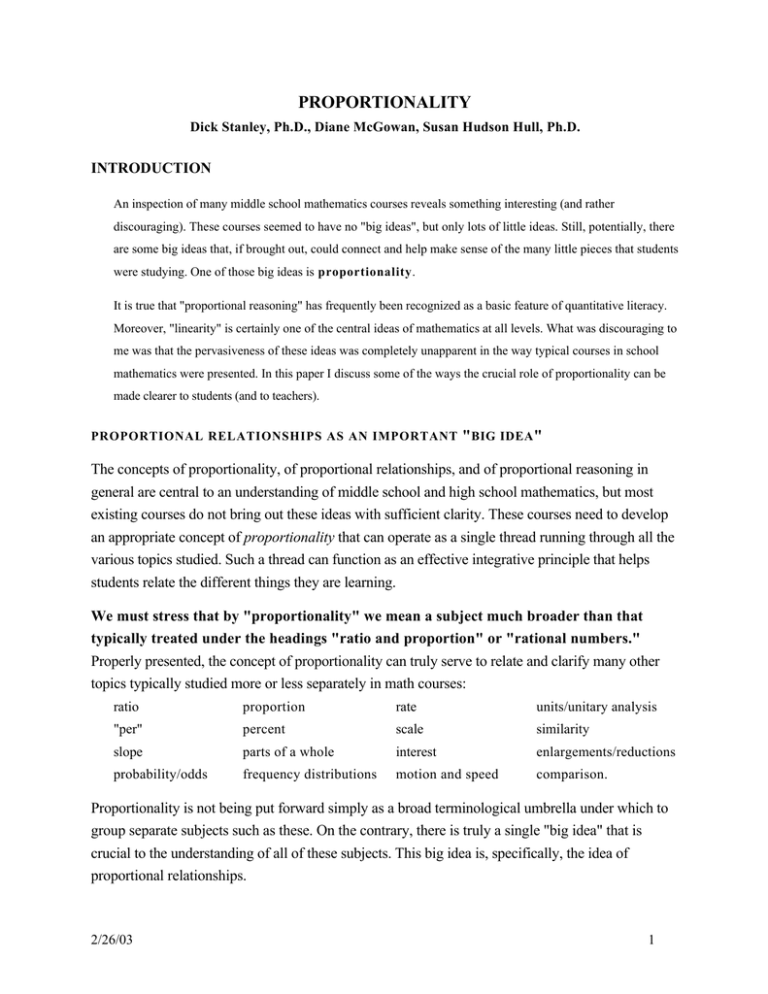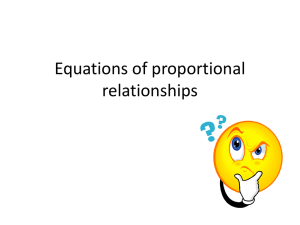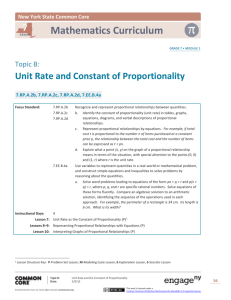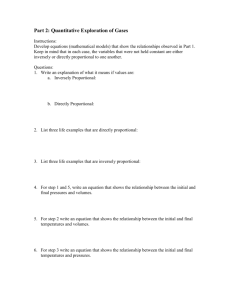PROPORTIONALITY INTRODUCTION Dick Stanley, Ph.D., Diane McGowan, Susan Hudson Hull, Ph.D.
advertisement

PROPORTIONALITY Dick Stanley, Ph.D., Diane McGowan, Susan Hudson Hull, Ph.D. INTRODUCTION An inspection of many middle school mathematics courses reveals something interesting (and rather discouraging). These courses seemed to have no "big ideas", but only lots of little ideas. Still, potentially, there are some big ideas that, if brought out, could connect and help make sense of the many little pieces that students were studying. One of those big ideas is proportionality. It is true that "proportional reasoning" has frequently been recognized as a basic feature of quantitative literacy. Moreover, "linearity" is certainly one of the central ideas of mathematics at all levels. What was discouraging to me was that the pervasiveness of these ideas was completely unapparent in the way typical courses in school mathematics were presented. In this paper I discuss some of the ways the crucial role of proportionality can be made clearer to students (and to teachers). PROPORTIONAL RELATIONSHIPS AS AN IMPORTANT "BIG IDEA " The concepts of proportionality, of proportional relationships, and of proportional reasoning in general are central to an understanding of middle school and high school mathematics, but most existing courses do not bring out these ideas with sufficient clarity. These courses need to develop an appropriate concept of proportionality that can operate as a single thread running through all the various topics studied. Such a thread can function as an effective integrative principle that helps students relate the different things they are learning. We must stress that by "proportionality" we mean a subject much broader than that typically treated under the headings "ratio and proportion" or "rational numbers." Properly presented, the concept of proportionality can truly serve to relate and clarify many other topics typically studied more or less separately in math courses: ratio proportion rate units/unitary analysis "per" percent scale similarity slope parts of a whole interest enlargements/reductions probability/odds frequency distributions motion and speed comparison. Proportionality is not being put forward simply as a broad terminological umbrella under which to group separate subjects such as these. On the contrary, there is truly a single "big idea" that is crucial to the understanding of all of these subjects. This big idea is, specifically, the idea of proportional relationships. 2/26/03 1 ILLUSTRATIONS OF PROPORTIONAL RELATIONSHIPS Several illustrations are given below of situations involving proportional relationships. In order to draw attention to the essential common feature of these examples, we first present two equivalent ways of characterizing what proportionality is: When two quantities vary in such a way that one of them is a constant multiple of the other, the two quantities are “proportional.” Equivalently, two quantities are proportional when they vary in such a way that they have a constant ratio. The examples that follow are generally expressed in terms of the "constant multiple" formulation of proportionality, since that is the one that is most natural to build on in later work. 1 The circumference of a circle is proportional to its diameter. In fact, the circumference of a circle is always pi times its diameter, where pi is the constant π ≈ 3.14 . 2 The amount of sales tax paid on an item is proportional to the cost of the item. If the sales tax rate is 7% , then the amount of the sales tax is .07 times the cost of the item. The fact that the sales tax is a constant multiple (.07) of the cost of the item is what makes the relationship between tax and cost a proportional one. 3 On a map that is drawn to scale, the distance between two real places is proportional to the distance between these two places as represented on the map. For example, if the scale is 1 to 100,000 , then the distance between two places is always 100,000 times their distance on the map. So real distances are a constant multiple (100,000) of map distances. 4 The amount of gasoline used on a trip is (roughly) proportional to the length of the trip. For example, if a car gets 22 miles per gallon, then the number of gallons of gasoline used is 1 roughly 22 times the number of miles traveled. 5 Commercials typically take up a certain fixed portion of the total broadcast time of a television program. Put differently, the commercial time is proportional to the total broadcast time. For example, if there are 6 minutes of commercials every half hour, then the commercial time is 6 2 30 = 10 of the total time. In this case the constant of proportionality is .2 . 6 How high a person can reach with an upstretched arm is roughly proportional to the person’s height. What is meant is that, in general, the taller a person is the higher that person can reach. Here, the meaning of the constant multiple is statistical rather than exact: on the average people can reach about 1.25 times their height. 2/26/03 2 7 The number of defective manufactured objects in a given batch is roughly proportional to the size of the batch, and this fact can be used to make counting tasks easier. For example, if a batch of 10,000 beads arrives and an inspection of 200 of them shows that there are 28 defective ones, it is likely that there will be about 14 defective ones in every 100 beads, and hence that the total number of defective beads is around 1,400 . 8 If we increase the size of a diagram by 50% , then distances in the enlarged diagram are proportional to distances in the original diagram. Specifically, every distance in the enlargement is a constant multiple (1.5) of the corresponding distance in the original. 9 If we are driving down a slope that has a 6% grade, then the drop in elevation as we drive is proportional to the horizontal distance we travel. Specifically, for every kilometer we travel horizontally, we drop 0.06 kilometer (60 meters) in elevation. 10 In the long run, the number of times you get a 7 in throwing two dice is proportional to the number of times you throw. Specifically, the number of times you get a 7 is the constant 1 multiple 6 of the number of times you throw. This is another way of saying that the 1 probability of a 7 is 6 . USING FUNCTIONS & GRAPHS TO REPRESENT PROPORTIONAL RELATIONSHIPS Understanding proportional relationships such as these is at the heart of even the most basic quantitative understanding of the world, and all students need to develop some kind of "proportional reasoning" that enables them to think clearly about these kinds of situations. One way of doing this effectively is to have students begin to think of proportional relationships in terms of functions. Specifically, writing y = k x is a way students can begin to express the relationship between two proportional quantities y and x using functions: the quantity y is proportional to, or depends on, or can be determined from, or is a function of, the quantity x . Students also need to become familiar with what a graph of such a relationship looks like: namely, a straight line through the origin. Similarly, students need to understand that all direct proportional relationships are "linear" relationships in the sense that the graph of every proportional relationship is a straight "line" (through the origin). The use of graphs as a visual representation of proportional relationships is very useful, and should be far more common than it is now. Too often, students in school study proportions only in the context of numbers and symbols, and hence miss out on an important vehicle for understanding. 2/26/03 3 THE CONSTANT OF PROPORTIONALITY In situations involving proportional relationships, one quantity is a constant multiple of the other; symbolically, y = k x. The constant multiplier k is called the constant of proportionality. It is the essential quantity connected with any situation involving proportionality. Still, its central character is sometimes missed by students since it shows up in such a variety of different forms depending on the context. Specifically, the constant of proportionality is the constant ratio in a proportion, the constant slope of a graph, the constant rate in rate situations, the scale in a map, the percent (divided by 100) that designates the part in part-whole situations, the scale factor linking two similar figures, the common trigonometric ratio of sides in a class of similar right triangles, and so forth. PROPORTIONAL RELATIONSHIPS IN THE SCHOOL CURRICULUM We make a beginning here of laying out more specifically how the idea of proportionality plays a role in various traditional middle and high school topics. Here, as is common, we use the word proportionality in its narrow sense of linearity or direct proportionality. a ratio: If two quantities are proportional (are in proportion), they have a constant ratio: b = k . Equivalently, one is a constant multiple of the other: a = k b. The reason to study ratios is that they are the means for describing proportional relationships. proportion: When two quantities a and b stand in the same proportion to one another as two a c other quantities c and d , this fact is often expressed in a "proportion": b = d = constant. units, unitary analysis, and "per": It is typical for constants of proportionality to be expressed using the term "per," which means roughly "for each." For example, wages may be expressed in the units of dollars per hour. A wage of eight dollars per hour is expressed as p = 8 h (pay in dollars equals 8 times the number of hours worked), and means that the person gets eight dollars "for each" hour worked. Here the constant of proportionality is the wage, its value is 8 and its units are "dollars per hour." rate: Constant rate situations often involve something proportional to the elapsed time. For example, when the rate of speed r is constant, the distance d traveled is proportional to the time t of travel: d = r t . The rate may be given, for example, in units of kilometers per second. Other rates do not involve time: for example, pricing gasoline at $1.25 per gallon involves a kind of rate, but not a rate associated in any way with time. percent: A percent is a number that expresses what portion one quantity is of another quantity that is used as a reference, where the reference is given the value 100 . 2/26/03 4 scale: In a scale drawing, real distances are proportional to distances on the drawing, and the constant of proportionality is the "scale" of the drawing. slope: The slope of a line in a graph, of a street, of a set of stairs, etc., is the ratio of the vertical change (rise) and the horizontal change (run) of a segment of the line or street or stairs. Thus the net vertical movement along a sloped straight line is proportional to the net horizontal movement, and the constant of proportionality is the slope. similarity: If one triangle is three times as large as another, similar triangle, then each length in the one is proportional to (is three times as large as) the corresponding length in the other; this is an external relationship between the two figures. There are also internal relationships within individual figures: looking at a whole set of similar triangles (for example, isosceles right triangles) the length of the hypotenuse is proportional to the length of a leg; specifically, the length of the hypotenuse of such a triangle is 2 times the length of a leg. probability and odds: When we know the odds or the probability of something succeeding, we know what proportion of the time we will succeed when we try. Here the reference value is the number 1 (whereas in percents it is the number 100 ). frequency distributions: Quite often, data that is collected for statistical purposes is turned into ratios, called "frequency distributions," that show the relative proportions of the quantities. interest: Simple interest involves a system where the interest earned is proportional to the time money is on deposit. (Compound interest is the same except that interest is computed at prescribed intervals and added in to the principal, so that the resulting growth is no longer strictly proportional to the original amount.) comparison: It is often useful to compare things in terms of proportions. For example, knowing that a file clerk's pay is 80% of a tutor's pay can give a better total picture than simply listing the actual pay of each. In other words, for purposes of comparing different pays it is easier to think in terms of proportions than in terms of absolute differences. direct variation: Another way of describing proportionality uses the term direct variation. Specifically, in pure linear functions y = mx, the quantity y is said to vary directly with the quantity x. This terminology is based on the very useful conception of functions as representing the covariation of two quantities: when the independent variable x varies (or changes), the dependent variable y changes along with x ; it "covaries" with x. Specifically, with pure linear functions y = mx, when x varies, y varies uniformly with x: any increase by 1 in x results in an increase by m in y. 2/26/03 5 NEXT STEPS This brief paper only scratches the surface. Much more needs to be said about the role of proportional relationships in the curriculum: 1 Many important relationships are not proportional, and students need to be studying these also; we are merely saying that a very strong initial foundation in proportional relationships is a useful way to begin. 2 A central use of functions as early as middle school may seem out of place until it is made clear that an appropriately simple, informal, concrete, and intuitive idea of function is intended. 3 The role of functions of the form y = b + kx needs to be discussed. In such functions, which have straight line graphs, the output is not proportional to the input, but a change in output is proportional to a change in input. 4 Classroom materials need to be developed which show the key role played by proportionality in such diverse subjects as geometry, statistics, probability, functions, and algebra. 5 In addition to the symbolic expression of proportionality (y = k x and so on), the language of proportionality needs to be used in school, and used properly, more often than it is now. Students need to know intimately words such as proportional, variation, direct proportion, and similar, and be fluent in such locutions as is proportional to, varies linearly with, is a linear function of, and stands in the same proportion as. 6 The classical school presentation of proportionality in terms of solving proportions has become quite fossilized, and does not lead easily to a useful and flexible understanding of the idea. (In fact, the use of the term "proportion" as meaning "an equality between two ratios" is largely limited to school mathematics books; the working use of this term in the "real world" is rather different.) To help here, the more modern ideas of functions as a way of expressing the mutual variation of two quantities need to more thoroughly and consistently replace the classical presentation. 2/26/03 6







